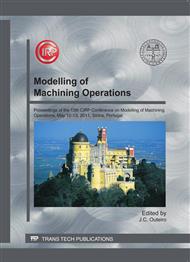[1]
J. Rech, G. Kermouche, W. Grzesik, C. Garcıa Rosales, A. Khellouki, V. Garcıa Navas: Characterization and modelling of the residual stresses induced by belt finishing on a AISI52100 hardened steel, Journal of materials processing technology", Vol. 208, p.187–195 (2008).
DOI: 10.1016/j.jmatprotec.2007.12.133
Google Scholar
[2]
X. Zhang, E. Gao, C. R. L.: Optimization of process parameter of residual stresses for hard turned surfaces. Journal of Materials Processing Technology, Vol. 209, p.4286–4291 (2009).
DOI: 10.1016/j.jmatprotec.2008.10.011
Google Scholar
[3]
H. K. Tönshoff, C. Arendt, R. B. Amor: Cutting of hardened steel. Annals of CIRP v.49, p.547–566 (2000).
DOI: 10.1016/s0007-8506(07)63455-6
Google Scholar
[4]
D. Y. Jang, T. R. Watkins, K. J. Kozaczek, K. J.; Hubbard, C. R.; O. B. Cavin: Surface residual stresses in machined austenitic stainless steel. Wear, Vol.194, pp.168-173 (1996).
DOI: 10.1016/0043-1648(95)06838-4
Google Scholar
[5]
Y. Matsumoto, M. M. Barash, C. R. Liu: Effect of hardness on the surface integrity of AISI 4340 steel. Journal of Engineering for Industry, v.108, pp.169-175 (1986).
DOI: 10.1115/1.3187060
Google Scholar
[6]
X. Sauvage, J. M. Le Breton, A. Guillet, A. Meyer, J. Teillet: Phase trans-formation in surface layers of machined steels investigated by X-ray diffraction and Mössbauer spectrometry. Materials Science and Engineering, Vol.A362, pp.-181-186 (2003).
DOI: 10.1016/s0921-5093(03)00531-8
Google Scholar
[7]
J. D. Thiele, S. N. Melkote, R. A. Peascoe, T. R. Watkins: Effect of cutting edge geometry and workpiece hardness on surface residual stresses in finish hard turning of AISI 2100 steel, J. Manuf. Sci. Eng, Vol. 122 p.642–649 (2000).
DOI: 10.1115/1.1286369
Google Scholar
[8]
J. Hua, D. Umbrello, R. Shivpuri: Investigation of cutting conditions and cutting edge preparations for enhanced compressive subsurface residual stress in the hard turning of bearing steel, Journal of Materials Processing Technology, Vol. 171, p.180–187 (2006).
DOI: 10.1016/j.jmatprotec.2005.06.087
Google Scholar
[9]
Y. B. Guo, A. W. Warren: The impact of surface integrity by hard turning vs. grinding on fatigue damage mechanisms in rolling contact, Surface & Coatings Technology, Vol. 203, p.291–299 (2008).
DOI: 10.1016/j.surfcoat.2008.09.005
Google Scholar
[10]
D. Ulutan, B. E. Alaca, I. Lazoglu: Analytical modeling of residual stresses in machining, Journal of Materials Processing Technology, Vol. 183, p.77–87 (2007).
DOI: 10.1016/j.jmatprotec.2006.09.032
Google Scholar
[11]
C. E. V. Salazar, S. Delijaicov, J. Kolososki, É. C. Bordinassi: Residual stresses in the SAE 52100 steel after heat treatment and turning, International Congress of Mechanical Engineering, COBEM, Annals of the 20th International Congress of Mechanical Engineering, 2009. p.1–7 (2009).
Google Scholar
[12]
A. Ramesh, S. N. Melkote: Modeling of white layer formation under thermally dominant conditions in orthogonal machining of hardened AISI 52100 steel. International Journal of Machine Tools & Manu-facture, Vol. 48, p.402–414 (2008).
DOI: 10.1016/j.ijmachtools.2007.09.007
Google Scholar
[13]
G. Poulachon, A. Alberta, M. Schluraff, I. S. Jawahir: An experimental investigation of work material microstructure effects on white layer formation in PCBN hard turning. International Journal of Ma-chine Tools & Manufacture, Vol. 45, p.211–218 (2005).
DOI: 10.1016/j.ijmachtools.2004.07.009
Google Scholar
[14]
A. Ramesh, S. N. Melkote, L. F. Allard, L. Riester, T. R. Watkins: Analysis of white layers formed in hard turning of AISI 52100 steel. Materials Science and Engineering Vol. A 390, p.88–97 (2005).
DOI: 10.1016/j.msea.2004.08.052
Google Scholar
[15]
S. Delijaicov: Experimental modeling of residual stress in the turning process of the DIN 100Cr6 hardened steel and it's correlation with the cutting forces, São Paulo, Tese (Doutorado) – Escola Politécnica da Universidade de São Paulo, 176p, (2004).
DOI: 10.11606/9786589190103
Google Scholar
[16]
C. E. V. Salazar: Evaluation by magnetic inspection of surface condition of the rolling rings of steel DIN 100Cr6 after dry hard turning. Thesis (PhD), Polytechnic School of the University of São Paulo, pp.67-135 (2008).
Google Scholar


